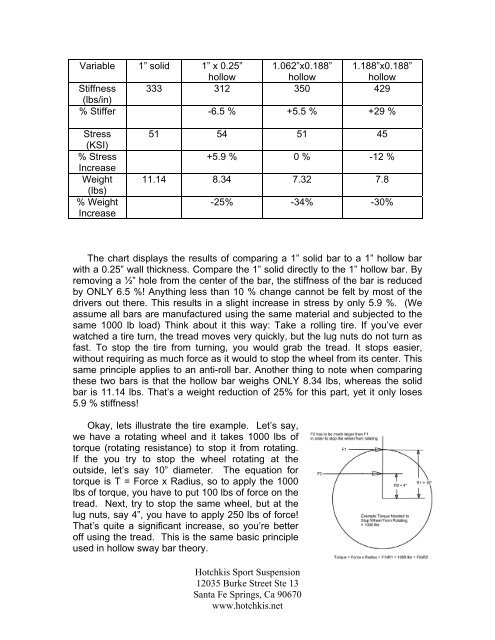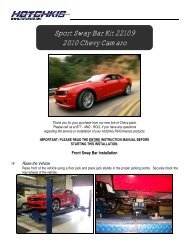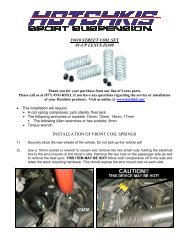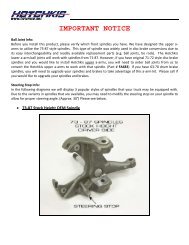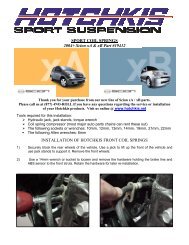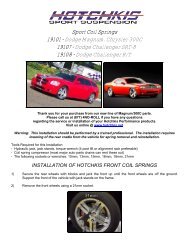Hollow Sway Bar Design Philosophy Race Car Technology for the ...
Hollow Sway Bar Design Philosophy Race Car Technology for the ...
Hollow Sway Bar Design Philosophy Race Car Technology for the ...
Create successful ePaper yourself
Turn your PDF publications into a flip-book with our unique Google optimized e-Paper software.
Variable 1” solid 1” x 0.25”hollow1.062”x0.188”hollow1.188”x0.188”hollowStiffness 333 312 350 429(lbs/in)% Stiffer -6.5 % +5.5 % +29 %Stress(KSI)% StressIncreaseWeight(lbs)% WeightIncrease51 54 51 45+5.9 % 0 % -12 %11.14 8.34 7.32 7.8-25% -34% -30%The chart displays <strong>the</strong> results of comparing a 1” solid bar to a 1” hollow barwith a 0.25” wall thickness. Compare <strong>the</strong> 1” solid directly to <strong>the</strong> 1” hollow bar. Byremoving a ½” hole from <strong>the</strong> center of <strong>the</strong> bar, <strong>the</strong> stiffness of <strong>the</strong> bar is reducedby ONLY 6.5 %! Anything less than 10 % change cannot be felt by most of <strong>the</strong>drivers out <strong>the</strong>re. This results in a slight increase in stress by only 5.9 %. (Weassume all bars are manufactured using <strong>the</strong> same material and subjected to <strong>the</strong>same 1000 lb load) Think about it this way: Take a rolling tire. If you’ve everwatched a tire turn, <strong>the</strong> tread moves very quickly, but <strong>the</strong> lug nuts do not turn asfast. To stop <strong>the</strong> tire from turning, you would grab <strong>the</strong> tread. It stops easier,without requiring as much <strong>for</strong>ce as it would to stop <strong>the</strong> wheel from its center. Thissame principle applies to an anti-roll bar. Ano<strong>the</strong>r thing to note when comparing<strong>the</strong>se two bars is that <strong>the</strong> hollow bar weighs ONLY 8.34 lbs, whereas <strong>the</strong> solidbar is 11.14 lbs. That’s a weight reduction of 25% <strong>for</strong> this part, yet it only loses5.9 % stiffness!Okay, lets illustrate <strong>the</strong> tire example. Let’s say,we have a rotating wheel and it takes 1000 lbs oftorque (rotating resistance) to stop it from rotating.If <strong>the</strong> you try to stop <strong>the</strong> wheel rotating at <strong>the</strong>outside, let’s say 10” diameter. The equation <strong>for</strong>torque is T = Force x Radius, so to apply <strong>the</strong> 1000lbs of torque, you have to put 100 lbs of <strong>for</strong>ce on <strong>the</strong>tread. Next, try to stop <strong>the</strong> same wheel, but at <strong>the</strong>lug nuts, say 4”, you have to apply 250 lbs of <strong>for</strong>ce!That’s quite a significant increase, so you’re betteroff using <strong>the</strong> tread. This is <strong>the</strong> same basic principleused in hollow sway bar <strong>the</strong>ory.Hotchkis Sport Suspension12035 Burke Street Ste 13Santa Fe Springs, Ca 90670www.hotchkis.net


